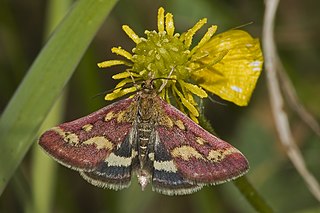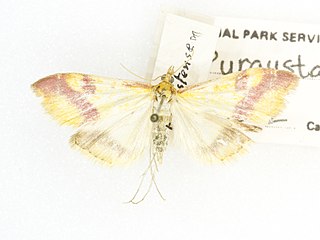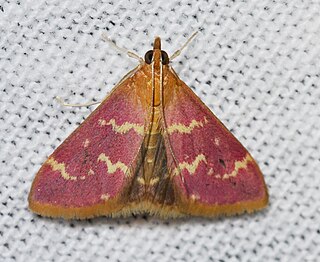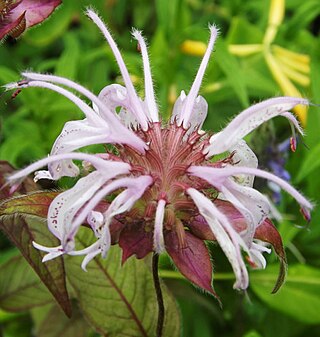
Crambidae comprises the grass moth family of lepidopterans. They are variable in appearance, with the nominal subfamily Crambinae taking up closely folded postures on grass stems where they are inconspicuous, while other subfamilies include brightly coloured and patterned insects that rest in wing-spread attitudes.

The mint moth is a small moth from the family Crambidae, also known by the common name Small Purple and Gold.

Schinia, commonly called flower moths, is a large genus of moths belonging to the family Noctuidae. The genus has a Holarctic distribution with the vast majority of species being found in North America, many with a very restricted range and larval food plant.

Ethmia pyrausta is a moth of the family Depressariidae. It is found in northern Scandinavia and adjacent Russia, as well as in China and Mongolia. The species is sometimes referred to as being "mythical", because it is so rarely encountered outside its remote native range. It is scarce resident in the UK and also found occasionally in other areas in Northern Europe.

Pyrausta purpuralis is a species of moth of the family Crambidae. It was described by Carl Linnaeus in his 1758 10th edition of Systema Naturae and is found in Europe. The species closely resembles Pyrausta aurata and Pyrausta ostrinalis. It is also known by the common name Common Purple & Gold.

Pyrausta is a speciose genus of moths of the family Crambidae. The genus was erected by Franz von Paula Schrank in 1802.

Dicerandra frutescens is a rare species of flowering plant in the mint family known by the common names scrub mint and scrub balm. It is endemic to Highlands County, Florida, where it is known only from the Lake Wales Ridge. Its habitat is quickly being lost as it is converted to residential and agricultural use. It was federally listed as an endangered species of the United States in 1985.

Pyrausta acrionalis, the mint-loving pyrausta moth, is a moth of the family Crambidae. It is found in eastern North America, including Alabama, Georgia, Massachusetts, Mississippi, New Hampshire, New York, Ontario, Tennessee, West Virginia and Wisconsin.

Pyrausta phoenicealis, the perilla leaf moth, is a moth of the family Crambidae described by Jacob Hübner in 1818. It is found worldwide, including the Americas, Africa, Australia and Asia.

Pyrausta californicalis, the California pyrausta moth or Mint Moth, is a moth in the family Crambidae. It was described by Alpheus Spring Packard in 1873. It is found in North America, where it has been recorded from British Columbia to California.

Pyrausta fodinalis is a moth in the family Crambidae. It was described by Julius Lederer in 1863. It is found in North America, where it has been recorded from British Columbia to Quebec and the north-eastern United States. It is also present in California, Nevada, Colorado and Wyoming. The habitat consists of undisturbed prairie and grassland areas.

Pyrausta generosa is a moth in the family Crambidae. It was described by Augustus Radcliffe Grote and Coleman Townsend Robinson in 1867. It is found in North America, where it has been recorded from Ontario to Alberta and to Florida and Missouri. The habitat consists of undisturbed areas in aspen parkland and mixed woods.

Pyrausta nicalis is a moth in the family Crambidae. It was described by Augustus Radcliffe Grote in 1878. It is found in North America, where it has been recorded from Quebec west to British Columbia, south to Colorado, Utah, Nevada and California.

Pyrausta rubricalis, the variable reddish pyrausta moth, is a moth in the family Crambidae. It was described by Jacob Hübner in 1796. It is found in North America, where it has been recorded from Illinois to New York, south to Florida and Louisiana. It is also reported from the west coast, from southern California to Washington. The wingspan is about 15 mm and adults have been recorded on wing from March to October.

Pyrausta scurralis is a moth in the family Crambidae. It was first observed and described by George Duryea Hulst in 1886. It is found in North America, where it has been recorded/reported in the Canadian provinces of Ontario, Manitoba and Saskatchewan to the US states, California, Arizona, and New Mexico and in Mexico.

Pyrausta signatalis, the raspberry pyrausta moth, is a moth in the family Crambidae. It was described by Francis Walker in 1866.

Pyrausta subsequalis, also known as the weedfield sable, is a moth in the family Crambidae. It was described by Achille Guenée in 1854. It is found in much of North America, where it has been recorded from southern Alberta and southern British Columbia south to Arizona and New Mexico and east to Florida and north to Ontario. The habitat consists of dry prairie areas.

Pyrausta unifascialis, the one-banded pyrausta, is a moth in the family Crambidae. It was described by Alpheus Spring Packard in 1873. It is found in North America, where it has been recorded from Quebec west to British Columbia, south to Arizona and California. The habitat consists of forest openings, clearings and fields.
Pyrausta borealis, the northern pyrausta moth, is a moth in the family Crambidae. It was described by Alpheus Spring Packard in 1867. It is found in North America, where it has been recorded from Newfoundland and Labrador west to British Columbia, north to Alaska and the Yukon. The habitat consists of boreal forests.

Monarda bradburiana, the eastern beebalm or Bradbury's beebalm, is a species of perennial flowering plant in the mint family, Lamiaceae, that is native to much of the southeastern United States.



















